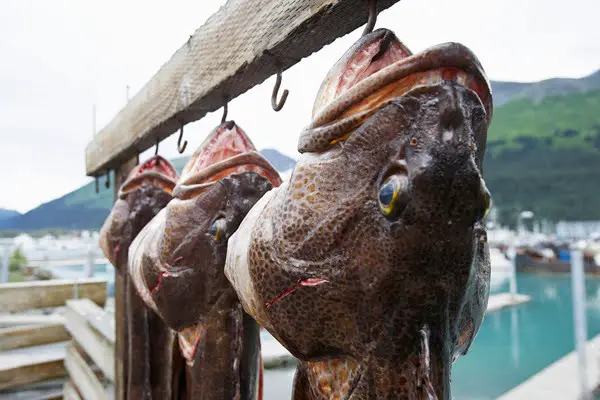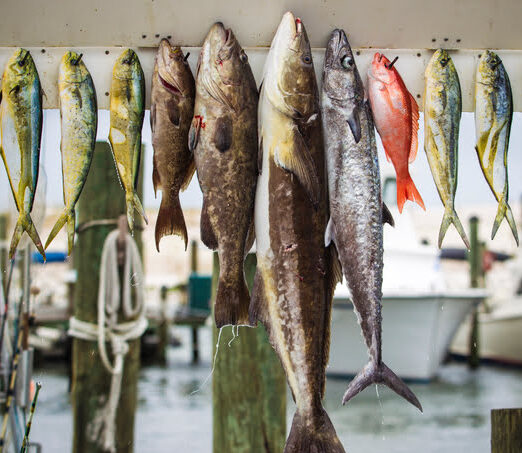Eating your catch can be one of the most fulfilling (and tastiest) parts of angling, especially if you stick to the fish that are known to be delectable!
But every once in a while I pull up a species that I know is legal to keep, but that I haven’t heard much about in terms of taste…
This is how I end up frying a small creek chub fillet in olive oil out of sheer curiosity, only to be sorely disappointed by the mushy, muddy taste.
This begs the question: Is there a fish out there that tastes so bad that it crosses the line into “not for human consumption?”
Grab some Pepto-Bismol and hold your nose, because we’re about to set out to find the worst-tasting fish out there!
Table of Contents
- What Is The Worst Tasting Fish?
- Cut Bottom Feeders some Slack
- It Starts with Chemistry
- Not-So-Essential Oils
- Urine Big Trouble: Urea in Fish Flesh
- The Stomach-Churning Meat of the Coelacanth
- Conclusion
What Is The Worst Tasting Fish?
While the taste of fish is somewhat subjective and dependent on how they’re prepared, a few fish species consistently rank amongst the worst tasting: Bowfin, Tench, Hardhead (saltwater) Catfish and False Albacore are all universally disliked.
Additionally, some farm-raised fish are said to taste muddy and bland, while their wild counterparts can be quite good.
Tilapia and Salmon are both known to taste totally different when raised on a fish farm or caught in the wild.
And then of course there are all sorts of fish delicacies that some people love, and others find totally repulsive, like Hakaral and Surströmming.

Let’s dive deeper into this topic…and why some fish taste so much worse than others.
Cut Bottom Feeders some Slack
There are many false leads when it comes to the worst-tasting fish, and one of them is bottom feeders.
Many sources online cite fish such as catfish, carp, and tench as the worst tasting fish. They are said to ‘taste like mud,’ due to their feeding habits. While this can be true, the issue here is that you’re eating mud, not fish!
Fish that feed on the bottom of water bodies can retain some mud in their systems, but there’s a simple trick to getting it out: purging!
Leave the fish alive in clean water overnight to allow the mud to leave the fish. Freshwater fish can be kept in a bathtub at home, and fresh and saltwater fish can all be kept in a net trap in the water they’re caught in.

Waiting to fillet the fish until after this purging period can seriously change and improve the taste by getting rid of the mud.
You may find that these fish are more agreeable, even tasty, once the mud is purged. After all, carp were originally brought to the US as a food fish!
Once you get only the meat, these fish taste pretty good. So our quest continues to find the worst-tasting fish… not the fish that lives in the worst-tasting environment!
It Starts with Chemistry
Even without bottom feeders, there are thousands upon thousands of species of fish out there, so before we can find the least tasty we should narrow down where to look.
If you’ve read our article on the best tasting fish, you may recall that the related chemicals trimethylamine oxide (TMAO) and trimethylamine (TMA) play a large role in giving fish their ‘fishy’ taste.
For a quick refresher, these chemicals protect marine animals’ proteins from the high pressures that come with living underwater. They rapidly begin to decompose upon their death, quickly putting out that distinct ‘fishiness’ that you can smell or taste.

Fish that live in saltwater environments tend to have more TMAO in their tissues than freshwater fish, so that’s where we’ll take a closer look for our search!
Not-So-Essential Oils
Fish, just like us, store fat in their tissues as fuel to burn when food is in short supply. But the ways that fish do this can be very different across species!
There are two main varieties: white fish and oily fish.
White fish account for the majority of the fish that people eat, and these fish only store fat in their livers. This leads to the lean, white, flaky flesh that one can come to expect from fish.
Oily fish, however, disperse this fat throughout their bodies. Their fillets can contain up to 30% oil, and as such their meat is much fattier and less flaky than white fish.
Oily fish don’t all taste bad- some fish have oils that many people love!
Salmon, trout, mackerel and tuna are all examples of fish that are chock-full of some very tasty oils. But in other species, the oil can ruin the experience big-time.

Ladyfish (Elops sp.) and Little Tunny/False Albacore (Euthynnus alletteratus). Both of these East Coast fish are filled to the gills with oils that most anglers say taste foul.
Ladyfish is noted in particular as tasting mushy as well as oily- doesn’t some oily fish mash sound tasty?
These fish are both edible and their flesh can be prepared in certain ways that improve the taste, but the taste is definitely… well, acquired is a nice word to use!
Urine Big Trouble: Urea in Fish Flesh
Yet another chemical that is known to create disagreeable odors and tastes in fish is urea.
The fish most well-known for having urea in their flesh are many species of shark, who use it to help regulate their body salt content. As the name suggests, this is the same chemical that occurs in human urine!
The side effect is that sharks’ flesh often smells and tastes strongly of ammonia, a very unpleasant experience. Rinsing the flesh with milk can reduce or even remove the urea, but it can be a hassle and isn’t guaranteed to work.

So we have two types of compounds that can make fish flesh taste downright nasty.
But what if there was a fish out there that had both of them, plus a whole host of others? What if this fish was also a living fossil, only recently rediscovered by science?
Buckle up, because this journey’s conclusion will take us millions of years into the past…
The Stomach-Churning Meat of the Coelacanth
The West Indian Ocean Coelacanth (Latimeria chalumnae) is an icon for fish enthusiasts and dino lovers alike on account of its long history and startling rediscovery.
These fish were known from fossils long before live specimens were ever caught, and it was believed that they had gone extinct entirely until one showed up at a fish market!

A member of the lobe-finned fish along with lungfish, the coelacanth has many tricks up its sleeve to regulate its body functions in the deep, cold environment where it lives.
This includes a whole bunch of both oils and urea… the worst of both worlds!
Coelacanth oil is said to be so rancid that the fish soils any others it’s stored with, even when alive.
The native people of South Africa have long called it Gombessa, which literally translates to “worthless,” and while it was eaten historically, this was largely only as a last resort.
The meat is said to be slimy, and smell and taste strongly of ammonia due to the urea. But that slime is hiding a secret weapon in the forms of a combination of waxes and esters.
Related: How To Tell If Fish Has Gone Bad (Smell, Touch, Taste)
When combined with the large quantity of oil, these ingredients work as a highly effective laxative.
Keep the bathroom within sight, because nausea, diarrhea, and other gastrointestinal and digestive problems are all commonly reported when eating coelacanth flesh!
The Coelacanth is endangered, so it shouldn’t be eaten at all regardless of taste.
Thankfully, you aren’t missing anything worth trying- the fish smells like ammonia, tastes like oily, fishy slime, and will send you running for the toilet soon after eating it!

Do You Love Seafood?
Conclusion
Many factors can contribute to a fish’s hostility to the taste buds and stomach, including TMAO, oil, urea, and other compounds.
These factors are mostly able to be negated when only one occurs in a fish, but the ancient coelacanth seems to have hit the lottery with all of them at once!
While taste is subjective and many anglers disagree on the plate-worthiness of certain species, the coelacanth is as close as we can get to an objectively awful fish that almost nobody can stomach.
That makes adventurous eaters like me feel a lot better about grilling up some creek chub fillets.
Thanks for reading!
You May Also Like: What Fish Tastes Like Chicken?

Growing up in Florida, I’ve been surrounded by saltwater my entire life…and I love sharing my passion with others.
To learn more about why I started Saltwater Mecca, visit the ABOUT page.
Thank you for reading this article. Browse around & have some fun!